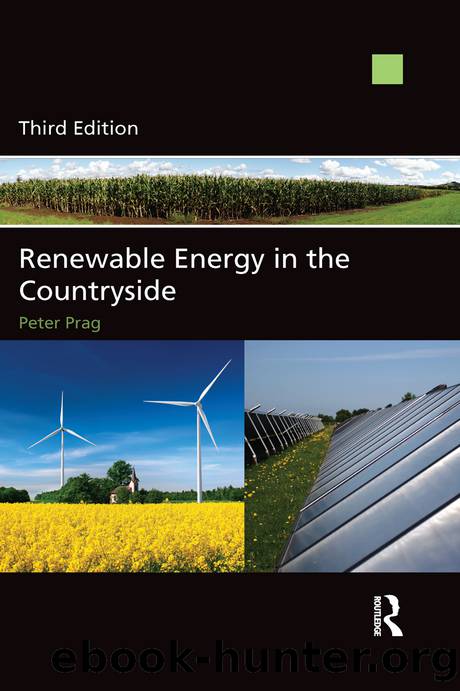Renewable Energy in the Countryside by Prag Peter;

Author:Prag, Peter; [Peter Prag]
Language: eng
Format: epub
ISBN: 1046954
Publisher: Estates Gazette, Limited
Timing
Location is one factor in determining the viability of growing biomass; another is timing, in terms of both seasonal production and the length of contract and commitment required from the grower. Some energy crops can be grown within an annual agricultural rotation, notably cereal straw, which is effectively a by-product of a normal arable system. That derives, of course, from the harvest that has to take place during a specific time, according to the weather and the condition of the crop, with the straw being baled immediately thereafter. The issue of contracts for cereal straw is dealt with in a later section, but in this context it may be mentioned that straw can be readily stored, whether in barns or outside stacks. Indeed, this has been a traditional practice for mixed farms when using straw for livestock bedding throughout the winter. The same storage can be used to meet the requirements of the purchasing power plant, which is likely to need batches of straw delivered over regular periods during the year. The method of storage will, however, have to be such as to come within the restricted moisture levels specified in the contract.
Miscanthus may also be cultivated as an annual crop, although its deep-rooting habit could cause problems at the end of the year if the land needed then to be reinstated for other crops. There could also be time restraints on reusing the land for food production if advantage had been taken of the opportunity of applying municipal waste as a fertiliser on the biomass. It is probably best then grown on a perennial basis. Harvest takes place over a wider time period than for cereals, between January and April, when the canes have shed their leaves and before they start to send up new shoots. When used for fuel, the crop is also stored in large bales and may then be delivered to the power station when required. Harvesting in the winter months has the advantage that there are fewer demands for other arable farm work at the time, so that the necessary resources may be more readily available. Operating heavy machinery over arable land in winter can be difficult, given wet and muddy conditions, as mentioned below in connection with SRC. These problems are mitigated to some extent with miscanthus thanks to its rhizome or root structure that provides a form of matting just beneath the surface of the soil.
The woody varieties of SRC, notably willow, involve a longer commitment in that they take four years before they can first be harvested and can then remain in production for up to as much as 30 years, although a time span of between about 15 and 20 years may be a more realistic commercial estimate. Contracts with processors will therefore need to provide growers with a degree of security over at least a reasonable period of time, especially when bearing in mind the investment that will have been made in coppice plants and possibly also in machinery. The
Download
This site does not store any files on its server. We only index and link to content provided by other sites. Please contact the content providers to delete copyright contents if any and email us, we'll remove relevant links or contents immediately.
| Automotive | Engineering |
| Transportation |
Whiskies Galore by Ian Buxton(41524)
Introduction to Aircraft Design (Cambridge Aerospace Series) by John P. Fielding(32883)
Small Unmanned Fixed-wing Aircraft Design by Andrew J. Keane Andras Sobester James P. Scanlan & András Sóbester & James P. Scanlan(32569)
Craft Beer for the Homebrewer by Michael Agnew(17927)
Turbulence by E. J. Noyes(7690)
The Complete Stick Figure Physics Tutorials by Allen Sarah(7135)
Kaplan MCAT General Chemistry Review by Kaplan(6588)
The Thirst by Nesbo Jo(6432)
Bad Blood by John Carreyrou(6270)
Modelling of Convective Heat and Mass Transfer in Rotating Flows by Igor V. Shevchuk(6219)
Learning SQL by Alan Beaulieu(6029)
Weapons of Math Destruction by Cathy O'Neil(5820)
Man-made Catastrophes and Risk Information Concealment by Dmitry Chernov & Didier Sornette(5641)
Digital Minimalism by Cal Newport;(5384)
Life 3.0: Being Human in the Age of Artificial Intelligence by Tegmark Max(5181)
iGen by Jean M. Twenge(5151)
Secrets of Antigravity Propulsion: Tesla, UFOs, and Classified Aerospace Technology by Ph.D. Paul A. Laviolette(4974)
Design of Trajectory Optimization Approach for Space Maneuver Vehicle Skip Entry Problems by Runqi Chai & Al Savvaris & Antonios Tsourdos & Senchun Chai(4837)
Electronic Devices & Circuits by Jacob Millman & Christos C. Halkias(4739)
